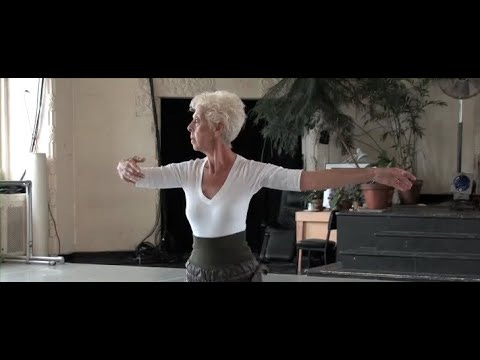Valda Setterfield died last month in Manhattan at the age of 88. If you never saw her dance, you’ve missed a unique artist who performed, memorably, with the Merce Cunningham Dance Company from 1964 to 1974 and then with her husband, David Gordon, and in his Pick Up Company.
In 1985, that troupe came to London to appear in the Dance Umbrella season. Because I knew Setterfield slightly—we had mutual friends, and I was studying with Cunningham when she was dancing with him—I approached her for an interview that was published, in two parts, in the Dancing Times.
Her recent death sent me back to our lengthy conversations, in which she spoke exactly as she danced, without pretense or embellishment. Remembering her fondly, I’ve selected these excerpts to honor her unique sensibility.
Her serious training began, she said, when “I went to audition for Rambert…I went into the Print Room at the Mercury [Theatre] and did two pliés and an arabesque for the secretary, in my street clothes, and she said, ‘That’s fine. We’ll take you.’ Then she took us in to see [Marie] Rambert teach, and Rambert was extraordinary, this amazing virago, and I was very excited.
“Rambert was wonderful for me because she decided that if you wanted to dance, well then, of course you should. She made it clear that anything was possible. There are stories of her saying to me, ‘Why did you come down from half- toe?’ and I said, ‘I wasn’t on balance,’ and she said, ‘The trouble with you is you only believe in what’s possible. You have to believe in what’s impossible. Look at me and do it.’ And one did it.
“What I thought, and it was supported by people who were interested in me, and there were always people interested in me even though I wasn’t strong, was that there would be someone who could create roles for me. And because I was in the Rambert situation, I thought if someone like [Antony] Tudor…I thought I would always be in long skirts, because it was my legs that were highly inarticulate and my torso and arms that were much more articulate. I thought I would play yearning, lovesick women; I tended to think about tragedy rather than comedy. And I felt if I could make this work, there would be special things I could do.”
When she arrived in New York in 1958, Setterfield worked with the choreographer James Waring, who suggested she attend Cunningham’s classes. At first she watched. “He taught this astonishing class with a very clear anatomical basis. It also took place in parallel, which was mind-boggling.
“Rhythmically the class was divine, and it had steps that I had never considered. I had considered what I could do based on what I knew there was, and what there was was pretty specific and clear. And suddenly I was seeing things that I had never seen and couldn’t name and couldn’t imagine—how extraordinary—but possibly I could do them. I began going to class, I think the very next day, and it was clear to me that this was absolutely where I belonged.
“I didn’t feel it was necessary to make a radical break with classical dancing, and I didn’t come to look for that. Merce was as riveting and amazing a force as Mim [Rambert] had been for me. My concept of long skirts and weeping and wailing was blown wide open. I actually used to go to Tudor too, to take ballet class. They weren’t mutually exclusive at all. And I knew, ruefully, that even though parallel made sense and made me strong and supported the turnout I had, if I’d had better extensions and could jump more and turn more, I would have been better off in Merce’s work too.
“I think he was always interested in me, but I was a problem in that I was not that technically strong. But I was rhythmically strong and I think he really adored that, and I asked him questions that interested him. I never had any trouble finding out what I wanted to know, and if he answered in some kind of roundabout way, maybe I could deduce that I was getting other information that was perhaps more to the point.
“When David and I began to work together, we went out on the road…We trusted each other and we knew enough about each other’s performing that we knew we could pull it off. We did a chair piece someplace in Pittsburgh where you could barely lift the chair over your head the ceiling was so low. We did it in a museum in California where the floor was desperately slippery because they always wax it on Wednesdays and nobody had told them not to. And we made it work.
“I sometimes am amazed at how strong I am at doing something. I sometimes am amazed at how weak I am at doing something. And he always pulls something out of the bag that makes it a new situation for me.
“I also seem to be embodying all the dance training I’ve ever had more than I ever did. Which is very interesting. It’s also preposterous—I should have retired years ago.”


How wonderful to see the Exercises on Six video here. Making it was such a glorious (to use Valda's adjective of choice) experience. Thank you for finding it and situating it here.-Nancy